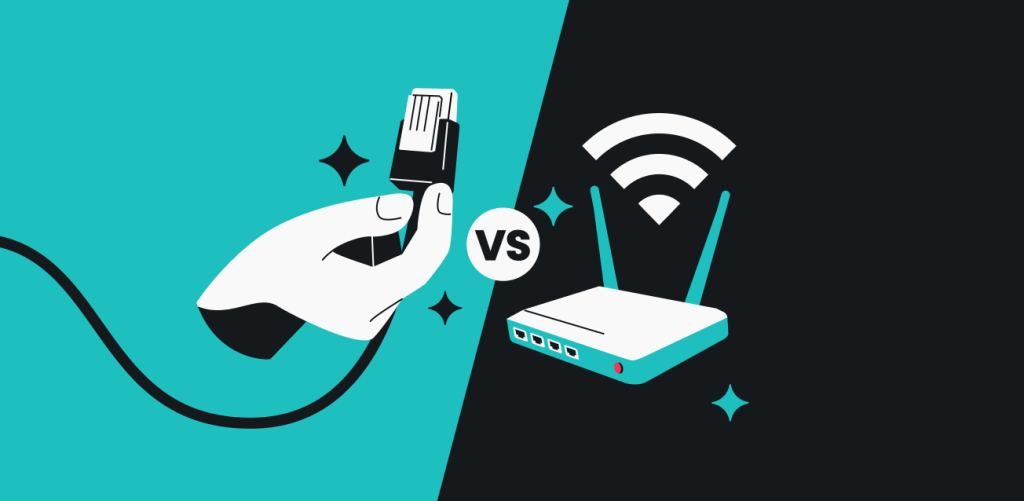
Internet quiz time: do you know, off the top of your head, what the difference between Ethernet and Wi-Fi is? No? Fortunately for you, I’m paid to know that, and I’ll tell you how the two differ. We’ll also discuss when to use Ethernet vs. when to use Wi-Fi.
Ethernet vs. Wi-Fi: what is the difference?
Ethernet is a wired internet connection between your device and the router via a cable. Wi-Fi is a wireless connection between your device and the router via radio signals.
Table of contents
What is Ethernet?
“Ethernet” is the name for computer networking technologies that are now used basically anywhere where data is transferred via a cable. That’s right; ethernet connections are those where devices connect to routers via cables to access the internet.
At home or the office, a wired ethernet connection will have a cable running from the router to your device (most likely a PC). Depending on the generation, an ethernet cable can carry tremendous traffic. It is also less susceptible to interference (as long as nobody cuts the wires). Plus, nobody can poach your internet connection or use it to infiltrate your device without physically accessing the wires.
There’s also the benefit of using an Ethernet cable to share your VPN-protected connection to devices that do not natively support VPN apps.
On the other hand, you will need to deal with a cable, which may create a tripping hazard or a mess in general. You’ll also need to get inventive if you’re hooking up a device in a room away from the router (we drilled a hole in the wall).
The common applications of Ethernet are:
- Reliable, high-speed internet connections over large areas;
- Supplying internet connection to your router;
- Internet connection for devices that require the best speed and stability.
Ethernet has a long history stretching back to 1975. That doesn’t mean the tech is ancient: it has evolved significantly over the years, both on the software and hardware side. While the original had speeds of 2.94 Mbit/s (or 367.5 kilobytes per second), the current hotness aims for 400 Gbit/s (or 50 Gigabytes per second).
The original ethernet cables could be, at most, 500 meters long and were around a centimeter in diameter. We currently use some speedy copper cables. Fiber optics are also employed; some go up to 100 kilometers in length. All those internet cables under the sea? Fiber optic.
Ethernet ports on your device are usually big and rectangular. However, you won’t find one on your phone, tablet, or newer laptops.
Ethernet pros & cons
Pros | Cons |
|---|---|
Stable connection | Requires physical infrastructure |
Low latency | Not easy to set up for multiple devices |
Higher security | Not suitable for mobile devices |
What is Wi-Fi?
Wi-Fi stands for “Wireless Fidelity,” and it’s maintained by the Wi-Fi Alliance. While Ethernet connects the device to the router via a physical wire, Wi-Fi works via radio waves. These can easily pass solid obstacles, so there’s no need to create an unobstructed path between the source and receiver.
The wireless router must still have a wired connection (most of the time).
The big downside of a Wi-Fi connection is that while radio waves can get through solid surfaces, they’re not immune to interference. So the connection isn’t equally good in all the areas it covers, and the quality may decrease sharply depending on the obstacles. It’s also easier to hack as the hacker doesn’t have to touch anything physically. Hackers could also clone your wireless access point and set up a fake one.
Plus, while the Wi-Fi signal may be strong, it’s shared by all the users connected to the specific hotspot. The bandwidth is then portioned out.
The common applications of Wi-Fi are:
- Providing hassle- and wire-free connection in places with dynamic audiences (cafes, bars, auditoriums);
- Supplying internet connection to many users with minimal infrastructural investment (schools, offices);
- Enabling Internet of Things (robot vacuums, etc.).
Multiple countries — Australia, the United States, and The Netherlands — claim to have invented Wi-Fi. Having been truly born in 1997, with the organization forming in 1999, it’s a much younger technology than Ethernet. Today, it is everywhere and especially important for anyone who wants to have an internet connection on the go.
Wi-Fi is the reason why my laptop doesn’t have an ethernet port. If I had a laptop dock, it could potentially have an ethernet connection.
Wi-Fi pros & cons
Pros | Cons |
|---|---|
Convenience and ease of setup | Connection more vulnerable to interference |
Supported by many device types | Lower speeds than Ethernet |
Covers a lot of ground without any wires | Higher latency/ping |
Ethernet and Wi-Fi comparison

So how do Ethernet and Wi-Fi stack up against each other?
Speed | Security | Stability | Convenience | |
|---|---|---|---|---|
Ethernet | High | High | High | Low |
Wi-Fi | Mid | Mid | Mid | High |
Is Ethernet better than Wi-Fi?
Ethernet is better than Wi-Fi under specific conditions.
If you need speed and stability more than anything else, you need Ethernet. It’s the best choice for online gaming.
If you want to maintain the connection while moving around, you need Wi-Fi, so you don’t have to drill walls and drag cables around. Wi-Fi is perfectly fine for any use case where latency or ping doesn’t matter that much — this covers most activities that aren’t gaming.
In conclusion: the right internet connection for the right task
Ethernet and Wi-Fi are not two competing brands — they have their own uses and are best at specific tasks.
So, really, the choice depends on your circumstances. Do you need to provide internet for a lot of moving people? Choose Wi-Fi. Need the best possible connection for streaming and gaming? Then Ethernet is your friend.
But whichever connection mode you use, a good VPN provides a lot of necessary protection.
FAQ
How much better is Ethernet than Wi-Fi?
Ethernet is better than Wi-Fi if you care about speed and connection stability. The numbers depend on the circumstances, but the latest Ethernet cables are supposed to deliver up to 10 Gbps, while Wi-Fi 6E is rated for up to 8 Gbps.
Do you need an Ethernet cable if you have Wi-Fi?
You will need an Ethernet cable if the device you want to connect to the internet doesn’t support Wi-Fi.
Will Ethernet cable reduce lag?
Using Ethernet instead of Wi-Fi can help reduce lag as long as it’s not caused by the server location or your sub-par internet plan.
Which is faster, Wi-Fi or Ethernet?
Ethernet is faster than Wi-Fi.



